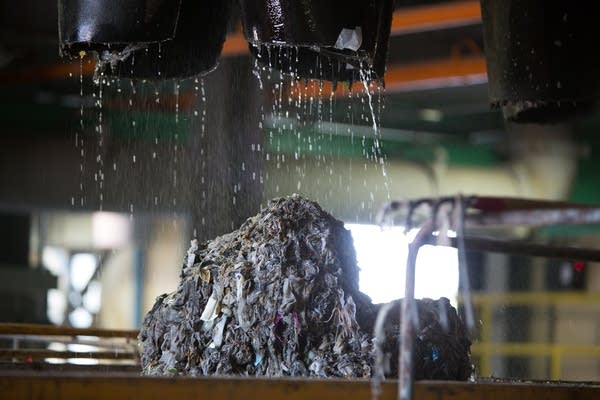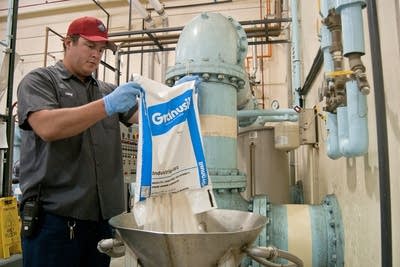Minnesota starts to think about re-using wastewater

Go Deeper.
Create an account or log in to save stories.
Like this?
Thanks for liking this story! We have added it to a list of your favorite stories.
The purple pipe carrying water city workers use to power wash their trucks means more than just cheering on the Minnesota Vikings.
It also signifies that the water spraying onto the rumbling trucks is what Mankato residents flushed down the drain. It's cleaned up, of course, then pumped into pipes painted purple -- the universal color among water system designers and engineers for re-used wastewater.
"They're usually more of a lavender, but here at the wastewater plant the guys are big Vikings fans so they're kind of a Viking purple color," Mankato public works director Mary Fralish said.

Minnesota's sole NFL team is plenty popular statewide. Purple wastewater pipes? Not so much.
Turn Up Your Support
MPR News helps you turn down the noise and build shared understanding. Turn up your support for this public resource and keep trusted journalism accessible to all.
• Beneath the Surface, a special Ground Level report
Mankato, where treated wastewater is used for everything from irrigation to industrial cooling, is one of the few places around this water-rich state where water is being recycled in this way. But as concerns about the availability of groundwater rise in certain parts of the state, interest in reusing wastewater is growing.
Slowly.
"It's phenomenal to be able to reuse that water. Sometimes there's an opportunity to use it a couple of times."
EXPENSIVE SOLUTION
Every year, Minnesotans take billions of gallons of water from the ground, rivers and lakes, use it once and send it down the Mississippi River. That might seem a potentially rich source for communities with rising water demand. But for now the economics make that a big challenge, said Bryce Pickart, who oversees wastewater planning at the Metropolitan Council. "Maybe over time it will fit in."
Treated wastewater coming out of municipal plants typically needs additional treatment to meet public health standards before it can be used again. But Pickart said if the Twin Cities wanted to reuse wastewater in a significant way, the bigger expense would be building new distribution infrastructure -- a system of purple pipes.
• More: U of M flushes toilets with rainwater

The systems are common in places like the dry Southwest, where communities of retirees provide the wastewater that keeps golf courses green year-round.
"Here we've had the abundance, or at least we thought we had the abundance of water, and so we haven't been pursuing it," Pickart said. "And now as we gather more data on what's going on with drawing down our groundwater aquifers, we need to make some changes heading into the future."
Statewide, three-quarters of Minnesotans get their drinking water from underground aquifers. In the Twin Cities metro area, more than two-thirds of residents packed into a smaller geographic area are tapping groundwater.
"It's a very clean product."
Meanwhile, roughly half of the state's wastewater, flushed into the sewer system from more than 60 cities, is cleaned up at the Met Council's Metro Plant in St. Paul. Every year, about 65 billion treated gallons join the Mississippi River on its trip to the Gulf of Mexico.
The process involves first filtering out items like condoms, tampons and the occasional rubber ducky. Then the rest of the solids are removed, and water moves to another series of tanks, some of which cover an area the size of more than 20 football fields.
In some of the tanks, microorganisms gobble up pollutants like phosphorus. In others, the cleanest water is skimmed off the top and sent for bleach treatment to kill bacteria. Finally, another agent is added to neutralize the bleach before it leaves the plant and joins the river.
"It's a very clean product," said Mike Mereness, the Metro Plant's assistant general manager of operations.
Although industries have inquired on and off over the years about tapping into that water, many of them have found other cheaper ways to satisfy their water demands.
"The challenge is, the industry would have to be next door or there would have to be a distribution system that would bring the water from here to wherever that industry is," Mereness said.
NICHE OPPORTUNITIES
Mankato started recycling wastewater through a unique set of circumstances. A new natural gas-fired power plant a couple miles away from the wastewater treatment plant was looking for a source of water for its cooling towers.
Tapping groundwater or Minnesota River water would have caused problems, so power company Calpine Corp. approached the city about finding an alternative. At the same time, the city knew its wastewater treatment plant would soon be due for an upgrade to meet state water pollution standards.
So in 2006, Calpine agreed to pay for a $22 million facility for the city that would add additional steps to the normal treatment process to meet state standards for wastewater reuse. The city owns and maintains the facility, which also gets rid of more phosphorus than many municipal treatment plants and helps reduce the nutrient load in the Minnesota River. Calpine can use the water for 20 years, as part of the agreement.
"The ick factor is what we call it."
Mankato generates more "reclaimed" water, as city officials call it, than the utility uses. So it washes trucks, sweeps streets and irrigates parks with it. This winter the city will even try it on the public outdoor ice rinks.
Fralish said even private landscaping trucks frequently come by to fill up their tanks. "It's becoming more popular all the time. I think right now we're selling it for $2.50 a unit, which is 750 gallons," she said.
Fralish acknowledges the arrangement is unique, but she said other communities in the state should think about it -- especially in places where officials are worried about groundwater supplies. Nearly 400 million gallons of wastewater were reused last year in Mankato -- about as much water as a population of 10,000 might use.
"It's phenomenal to be able to reuse that water," she said. "And sometimes there's an opportunity to use it a couple of times, so there's even more opportunities out there to look for."

State officials predict situations like Mankato's will become more common in the future. Not only are there more areas where groundwater supplies are strained, but reusing wastewater can also cut down on the nutrients that pollute the state's rivers, said Gene Soderbeck, the southwest regional municipal and industrial waste supervisor for the Minnesota Pollution Control Agency.
In addition, Soderbeck said, the increased frequency of long dry spells are driving up irrigation demands, creating more opportunity. Planners who had long grappled over how to dispose of wastewater are thinking differently, he said.
"It's shifting into, 'How can I reuse this resource?' " he said.
Still, he said, wastewater reuse is in its infancy because in most cases, water users have other options.
"It all boils down to economics and do I have another source. If I don't have another source, suddenly I can pay more than I would otherwise pay," he said.
Besides the Mankato example, treated municipal wastewater is being used to irrigate eight golf courses around the state and for irrigating crops that will be fed to livestock. One of the barriers to tapping more wastewater for irrigation is that a lot of homeowners who use groundwater install water softeners, which add salt to the water.
"That can build up over time and become toxic to plants," the Met Council's Pickart said.
That's why it might make more sense to reuse stormwater or switch some communities to surface water for irrigation needs than to figure out a way to reuse wastewater high in salts, which would require expensive reverse osmosis treatment, he said.
TOILET TO TAP?
And the closer treated wastewater comes into contact with humans, the more public health protections there are. Minnesota is more likely to see reused wastewater applications in agriculture and manufacturing than purple pipes hooked up to homes. State plumbing codes currently don't allow it.
But with advanced treatment technology, wastewater can be cleaned up enough to drink it, and they're already doing so in drought-plagued Texas. No one is seriously suggesting that in Minnesota, but one community in the southwestern Twin Cities suburbs is ready if it comes to that.

In the late 1990s, cities in that region faced groundwater restrictions because their pumping was affecting an important wetland, the Savage Fen. That included the Shakopee Mdewakanton Sioux Community, where Stan Ellison serves as land and natural resources director.
"It was pretty clear that pumping the groundwater was causing surface water issues even, you know, 15 years ago," he said. "Nobody wanted to talk about it though, because it's Minnesota and we've got all the water we need."
That discussion on how groundwater pumping affects surface water is happening again in the northeast metro suburbs because of low water levels in White Bear Lake. The Department of Natural Resources launched discussions earlier this year with groundwater users to not only address White Bear Lake but to also ensure sustainable groundwater use for a growing region.
Ellison said that earlier push to conserve drove the Mdewakanton to begin using treated wastewater to irrigate flower beds at Mystic Lake Casino Hotel and keep the golf course green. In the summer, that means the community is pumping up to a third less groundwater than before.
But that's not all. The community also tested a system that would inject treated wastewater back into the ground to recharge the aquifer used for drinking water. Ellison says it would work, but there are several challenges. It's expensive, and one of the biggest challenges is convincing people it's OK to mix a drinking water supply with treated water from flushed toilets.
"The ick factor is what we call it, that this is just icky and terrible to do. The injection, that's something we're kind of holding in our back pocket for the future," he said.
If groundwater supplies dwindle in more parts of the state, the water in bathrooms and laundry rooms might need to be recycled, just like residents decided to do years ago with our soda cans and milk jugs.
But the MPCA's Soderbeck says there are still too many unknowns with wastewater, namely chemicals washed down the drain in low concentrations. There is evidence these contaminants of emerging concern can build up in the environment, including groundwater.
"When you figure out and date some of the water that we're drinking right now out of the groundwater, some of it's over 100 years old. Do you want the stuff that we just put in there yesterday?" he asked. "We're not ready to go there."






